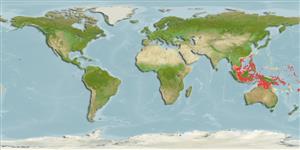>
Gobiiformes (Gobies) >
Gobiidae (Gobies) > Gobiinae
Etymology: Amblyeleotris: Greek, amblys = darkness + The name of a Nile fish, eleotris (Ref. 45335).
Eponymy: Dr John ‘Jack’ Ernest Randall Jr. [...] (Ref. 128868), visit book page.
More on authors: Hoese & Steene.
Environment: milieu / climate zone / depth range / distribution range
Ecología
marino asociado a arrecife, usually 25 - 50 m (Ref. 27115). Tropical; 22°C - 25°C (Ref. 27115); 30°N - 20°S
Western Pacific: Moluccas to the Solomon Islands, north to Ryukyu Islands, south to the northern Great Barrier Reef; Palau in Micronesia.
Tamaño / Peso / Age
Maturity: Lm ? range ? - ? cm
Max length : 12.0 cm SL macho / no sexado; (Ref. 48637)
Short description
Claves de identificación | Morfología | Morfometría
Espinas dorsales (total) : 7; Radios blandos dorsales (total) : 12; Espinas anales: 1; Radios blandos anales: 12. Characterized by white body color; head and body with seven narrow orange bars; first dorsal fin with prominent pale-edged black spot and numerous smaller white spots; tall and fan-like first dorsal fin; separate pelvic fins, joined only by low membrane at base of fins; without median predorsal scales; cycloid scales embedded extending forward on side of nape slightly anterior to upper end of operculum; longitudinal scale series 54-63; greatest depth of body 4.9-5.7 in SL; caudal fin usually longer than head (Ref. 90102).
Occurs on patches of carbonate sand of clear water reefs (Ref. 9710). Usually in rubble caves Lives with an olivaceus prawn with short white transverse marks (Ref. 48637).
Life cycle and mating behavior
Madurez | Reproducción | Puesta | Huevos | Fecundidad | Larva
Myers, R.F., 1991. Micronesian reef fishes. Second Ed. Coral Graphics, Barrigada, Guam. 298 p. (Ref. 1602)
IUCN Red List Status (Ref. 130435: Version 2024-2)
Threat to humans
Harmless
Human uses
Pesquerías: comercial; Acuario: Comercial
Herramientas
Special reports
Download XML
Fuentes de Internet
Estimates based on models
Preferred temperature (Ref.
123201): 25.5 - 28.7, mean 27.3 °C (based on 66 cells).
Phylogenetic diversity index (Ref.
82804): PD
50 = 0.5000 [Uniqueness, from 0.5 = low to 2.0 = high].
Bayesian length-weight: a=0.00724 (0.00339 - 0.01546), b=3.10 (2.92 - 3.28), in cm total length, based on LWR estimates for this (Sub)family-body shape (Ref.
93245).
Nivel trófico (Ref.
69278): 3.4 ±0.4 se; based on size and trophs of closest relatives
Resiliencia (Ref.
120179): Alto, población duplicada en un tiempo mínimo inferior a 15 meses (Preliminary K or Fecundity.).
Fishing Vulnerability (Ref.
59153): Low vulnerability (10 of 100).
Nutrients (Ref.
124155): Calcium = 115 [52, 213] mg/100g; Iron = 0.695 [0.362, 1.327] mg/100g; Protein = 17.9 [16.0, 19.6] %; Omega3 = 0.0921 [, ] g/100g; Selenium = 25.5 [12.3, 55.0] μg/100g; VitaminA = 129 [35, 442] μg/100g; Zinc = 1.87 [1.22, 2.76] mg/100g (wet weight);
